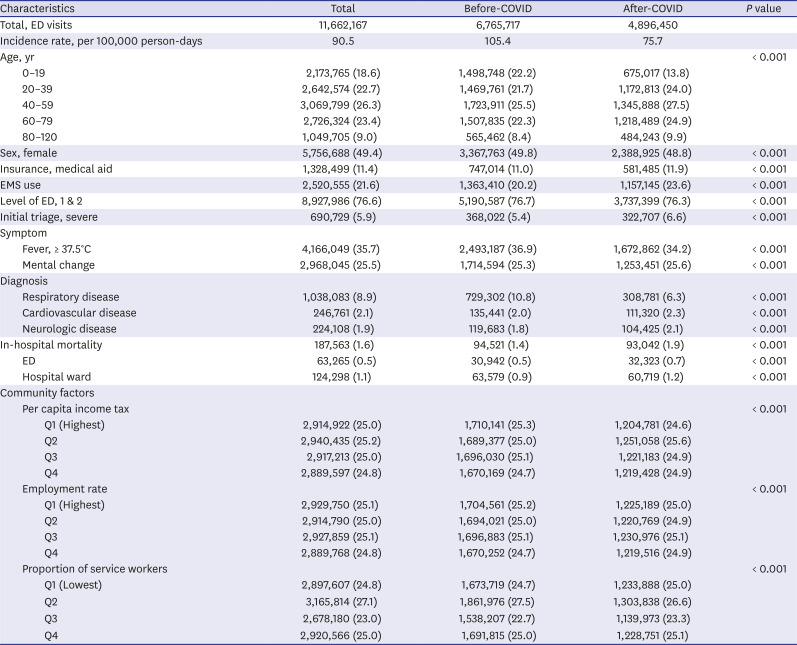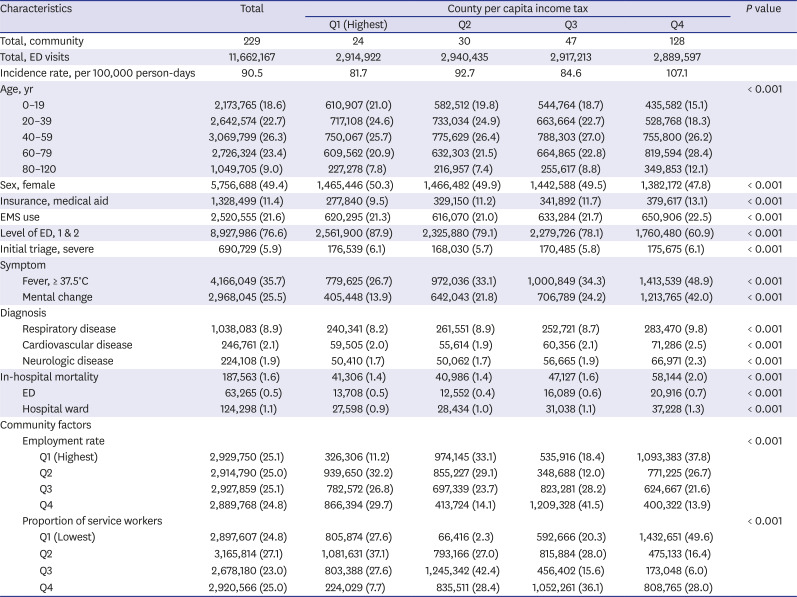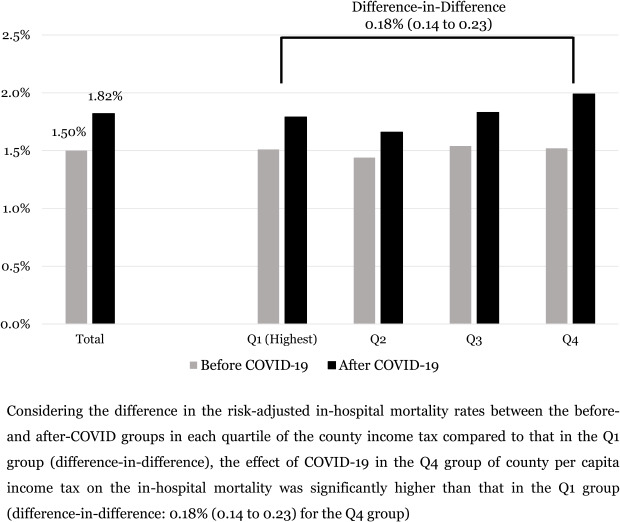2. Calderón-Larrañaga A, Vetrano DL, Rizzuto D, Bellander T, Fratiglioni L, Dekhtyar S. High excess mortality in areas with young and socially vulnerable populations during the COVID-19 outbreak in Stockholm Region, Sweden. BMJ Glob Health. 2020; 5(10):e003595.

3. Birkmeyer JD, Barnato A, Birkmeyer N, Bessler R, Skinner J. The impact of the covid-19 pandemic on hospital admissions in the United States. Health Aff (Millwood). 2020; 39(11):2010–2017. PMID:
32970495.


4. Hawkins RB, Charles EJ, Mehaffey JH. Socio-economic status and COVID-19-related cases and fatalities. Public Health. 2020; 189:129–134. PMID:
33227595.



5. Rahmatinejad Z, Tohidinezhad F, Reihani H, Rahmatinejad F, Pourmand A, Abu-Hanna A, et al. Prognostic utilization of models based on the APACHE II, APACHE IV, and SAPS II scores for predicting in-hospital mortality in emergency department. Am J Emerg Med. 2020; 38(9):1841–1846. PMID:
32739855.


6. Murao S, Yamakawa K, Kabata D, Kinoshita T, Umemura Y, Shintani A, et al. Effect of earlier door-to-CT and door-to-bleeding control in severe blunt trauma: a retrospective cohort study. Research Square. Forthcoming. 2020; DOI:
10.21203/rs.3.rs-23452/v1.

7. Galobardes B, Shaw M, Lawlor DA, Lynch JW, Davey Smith G. Indicators of socioeconomic position (part 1). J Epidemiol Community Health. 2006; 60(1):7–12.


8. Bassuk SS, Berkman LF, Amick BC 3rd. Socioeconomic status and mortality among the elderly: findings from four US communities. Am J Epidemiol. 2002; 155(6):520–533. PMID:
11882526.


9. Winkleby MA, Cubbin C. Influence of individual and neighbourhood socioeconomic status on mortality among black, Mexican-American, and white women and men in the United States. J Epidemiol Community Health. 2003; 57(6):444–452. PMID:
12775792.

10. Rawshani A, Svensson AM, Zethelius B, Eliasson B, Rosengren A, Gudbjörnsdottir S. Association between socioeconomic status and mortality, cardiovascular disease, and cancer in patients with type 2 diabetes. JAMA Intern Med. 2016; 176(8):1146–1154. PMID:
27367969.


11. Lee SY, Song KJ, Shin SD, Ro YS, Hong KJ, Kim YT, et al. A disparity in outcomes of out-of-hospital cardiac arrest by community socioeconomic status: a ten-year observational study. Resuscitation. 2018; 126:130–136. PMID:
29481908.


12. Chang I, Ro YS, Shin SD, Song KJ, Park JH, Kong SY. Association of dispatcher-assisted bystander cardiopulmonary resuscitation with survival outcomes after pediatric out-of-hospital cardiac arrest by community property value. Resuscitation. 2018; 132:120–126. PMID:
30237060.


13. Davis JR, Wilson S, Brock-Martin A, Glover S, Svendsen ER. The impact of disasters on populations with health and health care disparities. Disaster Med Public Health Prep. 2010; 4(1):30–38. PMID:
20389193.



14. Rossen LM, Branum AM, Ahmad FB, Sutton P, Anderson RN. Excess deaths associated with COVID-19, by age and race and ethnicity—United States, January 26–October 3, 2020. MMWR Morb Mortal Wkly Rep. 2020; 69(42):1522–1527. PMID:
33090978.


15. Jung E, Park JH, Lee SY, Ro YS, Hong KJ, Song KJ, et al. Mechanical chest compression device for out-of-hospital cardiac arrest: a nationwide observational study. J Emerg Med. 2020; 58(3):424–431. PMID:
32178958.


16. Cha WC, Ahn KO, Shin SD, Park JH, Cho JS. Emergency department crowding disparity: a nationwide cross-sectional study. J Korean Med Sci. 2016; 31(8):1331–1336. PMID:
27478347.



19. Magnani C, Azzolina D, Gallo E, Ferrante D, Gregori D. How large was the mortality increase directly and indirectly caused by the COVID-19 epidemic? An analysis on all-causes mortality data in Italy. Int J Environ Res Public Health. 2020; 17(10):E3452. PMID:
32429172.

20. Roberton T, Carter ED, Chou VB, Stegmuller AR, Jackson BD, Tam Y, et al. Early estimates of the indirect effects of the COVID-19 pandemic on maternal and child mortality in low-income and middle-income countries: a modelling study. Lancet Glob Health. 2020; 8(7):e901–8. PMID:
32405459.

21. Hernández-Vásquez A, Gamboa-Unsihuay JE, Vargas-Fernández R, Azañedo D. Excess mortality in Metropolitan Lima during the COVID-19 pandemic: A district level comparison. Medwave. 2020; 20(8):e8031. PMID:
33017383.

22. Drefahl S, Wallace M, Mussino E, Aradhya S, Kolk M, Brandén M, et al. A population-based cohort study of socio-demographic risk factors for COVID-19 deaths in Sweden. Nat Commun. 2020; 11(1):5097. PMID:
33037218.



23. de Lusignan S, Dorward J, Correa A, Jones N, Akinyemi O, Amirthalingam G, et al. Risk factors for SARS-CoV-2 among patients in the Oxford Royal College of General Practitioners Research and Surveillance Centre primary care network: a cross-sectional study. Lancet Infect Dis. 2020; 20(9):1034–1042. PMID:
32422204.



24. Östlin P, Diderichsen F. Equity-Oriented National Strategy for Public Health in Sweden. Copenhagen, Denmark: WHO Regional Office for Europe;2001.









 PDF
PDF Citation
Citation Print
Print




 XML Download
XML Download